#Textiles
Explore tagged Tumblr posts
Text








embroidered and beaded dress borders, french c. 1800s.
4K notes
·
View notes
Text
I do this with all my secondhand wool fabrics, though with a week of thawing because that's how long my mother said to do it.
It also applies to feathers and especially fur! In the hierarchy of moth tastiness vintage furs are very high on the list. They like fluffy things better than smooth tightly spun things, and they like dirty things better than material that's clean and full of sizing, so old furs are extremely edible as well as full of hiding places. And they will eat feathers, I've seen it :(
I'm told that they will also eat silk but only if it's sufficiently dirty.
reminder that if you ever buy wool yarn secondhand you should put it in a plastic bag in the freezer for a week, let it thaw 24 hours, then refreeze another week. this makes sure that if there are any moths or pests they are killed by the first freeze, and the remaining eggs are lured to hatch by the thawing and then killed with the second freeze. until this process is complete you must keep the yarn isolated from your existing stash or you risk any infestation spreading. i buy a lot of wool yarn from thrift and antique shops and always do this and have never had a problem with moths or other bugs. if you buy wool sweaters or other wool things secondhand you should also do this just to be safe
7K notes
·
View notes
Text
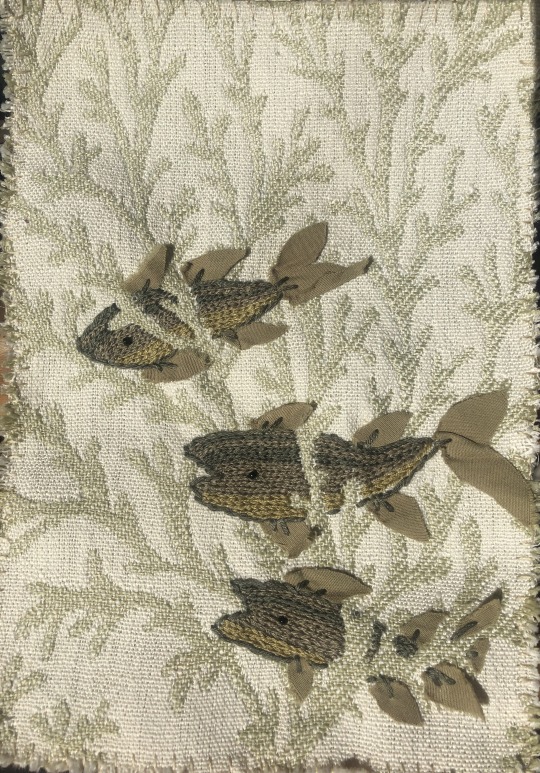
ID: three fish embroidered on an upholstery sample with a design that looks like coral. the fish are embroidered so they appear to be swimming in between the coral. the colors are shades of olive green and beige.
20K notes
·
View notes
Text
Maintaining the biodiversity of sheep is not just important for knitters and spinners, but for the health of the environment. Essentially, a sheep functions like a carbon sequestration system. Atmospheric carbon makes up 50 percent of wool's weight, and, unlike synthetic fabrics, wool is naturally biodegradable. When disposed of, wool acts like a fertilizer, slowly releasing valuable nutrients and carbon back into the soil. Wool fixed carbon in the topsoil rather than releasing it into the atmosphere. This process can help regenerate pastures, which sheep will graze. And sheep can help answer the problem of how to avoid far-flung fiber supply chains. Because sheep do well in such an extraordinary range of terrains, wool is a natural choice for people interested in rebuilding local systems of cloth manufacture. Certain breeds are more suited to certain atmospheric and geologic conditions than others, so preserving diversity also means preserving the geographic range in which sheep can flourish.
Sofi Thanhauser, Worn: A People’s History of Clothing
4K notes
·
View notes
Text

There were times I was kind when I should have been cruel and times I was cruel when I should have been kind.
14K notes
·
View notes
Text
One. I am pretty sure that the way that sheep were bred has caused it so that they actually need to be sheered constantly or they will have issues. They are also domestic animals and can no longer live on their own in the wild. So we might as well keep them around and keep sheering them since it provides clothing for us and life for them. Besides. Do people complain about dogs and other house pets getting haircuts/groomed? It’s just a haircut.
Two. For leather. I don’t think our population is ever going to give up on eating meat. And if it did, most of those animals are domestic and can’t live in the wild. So. We are going to keep eating meat. And if we keep eating meat, we can either waste everything else from the animal that we don’t use (which is stupid and I feel kind of disrespectful to the animal) or we can use all of it and continue to make leather and other things. I know it’s not the best thing to think about. But the other options are to either throw away the leather or cull the herds of animals that we will no longer be eating and won’t be kept as pets and won’t be able to live on their own. Like. We also couldn’t just release a bunch of animals out into the wild. Especially if there are no natural predators. Just look at what happens in areas with deer and no wolves. The deer overpopulate and destroy everything. Which brings me to deer. We can’t exactly stop hunting deer because we have to keep their population down or the environment and a lot of other things will suffer. Humane or not. This is how life is on our planet and at least right now we do not have a way of stopping it flat out.
As for furs. I don’t really have anything to say since I do not know much about the fur industry.
no but genuinely I lose a little more patience for people who won't wear wool, leather, silk, or fur every day that I live in a world where plastic is increasingly the only damn kind of clothing you can find (or the only kind of fabric for sewing, even)
obviously, animal cruelty is horrible. I believe that even industries that rely on the deaths of animals should make their lives as good and their ends as humane as possible. and many of these industries need tighter environmental regulations on their production practices- some of the chemicals involved are highly toxic and ill-controlled at times
but at some point, you have to wake up to the fact that the only alternative we've found to date is destroying our planet
it's all plastic. and plastic is horrible for the world- the environment, humans, and especially animals. how cruelty-free is it to cause mass habitat loss? or climate change that disrupts food sources for those animals on a vast scale? how is that better than the deaths of a relatively small proportion of animals comparatively?
(and don't even start with "but pineapple leather! but cactus leather!" when those are still basically plastic due to heavy plastics use in their production processes. there is currently no non-plastic alternative to most animal-based textile products)
I've always tried to keep in mind that we all have to decide where our line is, that we all consume and there's no way of living in this world that doesn't take something from it. that for me, plastic clothing is to be avoided as much as possible, and for others, animal clothing products are to be avoided as much as possible. that the choice is equally valid
but I'm having a hard time seeing it as valid anymore when it just feels like trying to push the unpleasant part away from yourself so you can pretend your choice has no negative impacts. you're not wearing animal skin (or wool that an animal didn't even die to produce), so surely your way of doing things is better! no animals were harmed in the making of your outfit!
except. they were.
they and all the rest of us.
4K notes
·
View notes
Text

"Is America Great Yet?" protest banner 1/? (Recycled fabric, Polyfil)
This first tapestry was created a few months ago, while Tr*mp was still signing executive orders to pull government funding from various organizations (cancer research, libraries, school districts, the list goes on) and funneling funding into the terrorist group that is called ICE. How exactly do these orders make this country great? The short answer: it doesn't.
Like many people, I have been struggling to keep calm during this horrific first year of Tr*mps presidency. Feeling powerless, I opted to start collecting phrases that describe my feelings in a short, concise way, and turning these phrases into tapestries that are inspired by protest banners.
#art of zi#artists on tumblr#small artist#contemporary art#contemporary artist#textiles#textile art#recycled art#fiber art#us politics#donald trump#trump administration
14 notes
·
View notes
Text

9 notes
·
View notes
Text
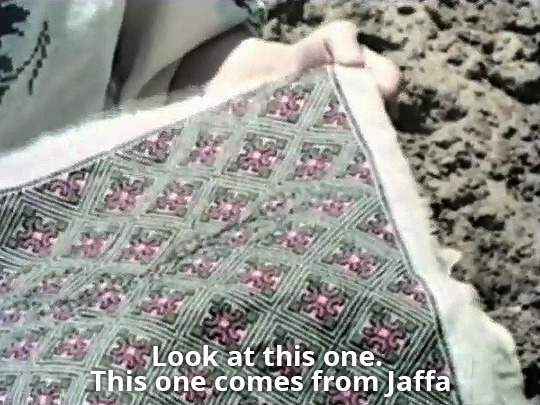
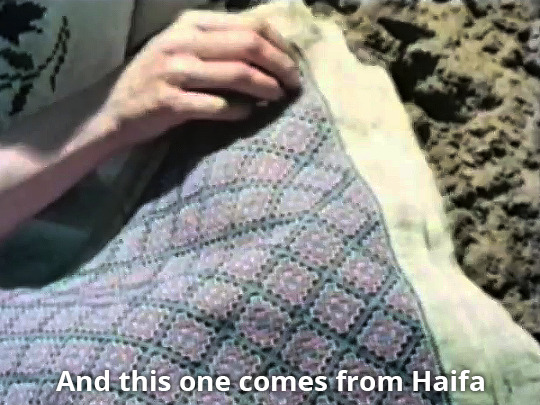
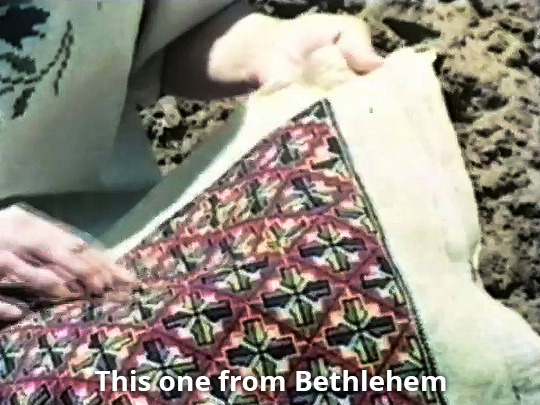
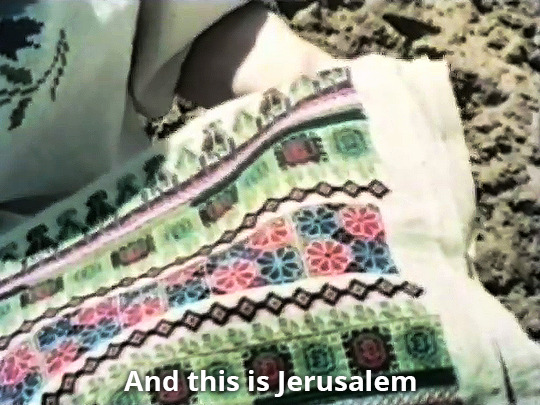
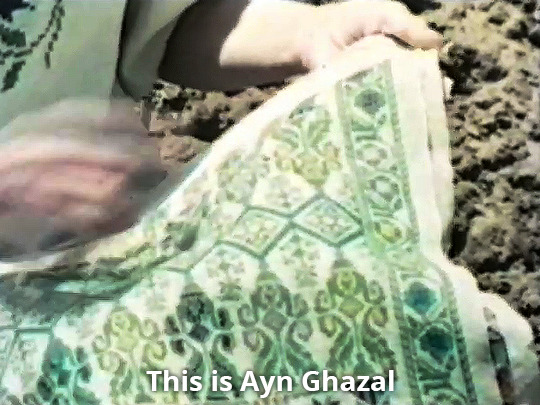
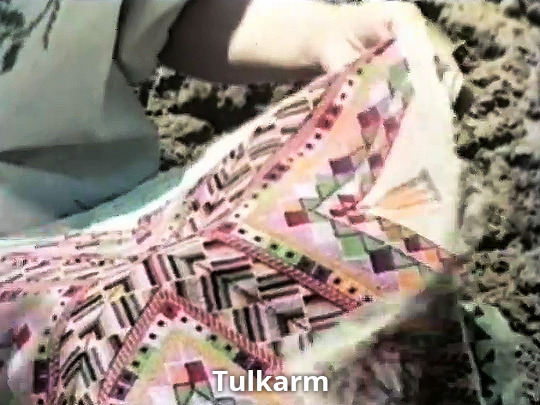
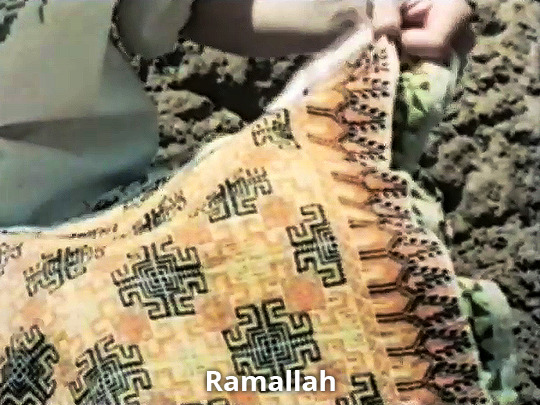

The Palestinian (1977)
#the palestinian 1977#vanessa redgrave#gaza#ramallah#tulkarm#ayn ghazal#jerusalem#bethlehem#haifa#jaffa#documentary#screencaps#post#history#tatreez#artistry#jerusalem and tulkarem my favess#textiles#art
56K notes
·
View notes
Photo
In the mood for embroidery...

Unknown, Detail from In Praise of Three Stars (Gods of Happiness, Longevity and Prosperity), Qing dynasty, Qianlong Period (1736-1795), 1782
Silk tapestry embroidered with silk and metallic threads, 150 5/8” x 58 3/8” in. VMFA
#textiles#silk#tapestry#embroidery#in praise of three stars#qing dynasty#qianlong era#artifact#history#aesthetic#china#chinese#chinese art#chinese aesthetic#Qing dynasty art#chinese moodboard#chinese history#chinese culture#chinese interior#chinese design#chinese artifact#ancient china#phoenix#chinese gods#qianlong#chinese embroidery#chinese textiles#chinese silk#chinese pattern#chinese patterns
355 notes
·
View notes
Text
If you want to learn more about Lorina Bulwer, there are multiple excellent resources: Ruth Battersby, who spoke at the event at Gressenhall, is Senior Curator of Costume and Textiles at Norfolk Museums Service, oversees several pieces of Bulwer’s embroidery, and focused her PhD dissertation on Lorina’s work. You can listen to an interview with her on Sew What Podcast Dolly Sen has written a short book about Lorina Bulwer published by Red Herring Press, and has recently received funding from Arts Council England to pursue further research into Bulwer’s embroidery through the lens of Disability Studies Dr Isabella Rosner🧵🪡 also featured Lorina as a case study in her book Stitching Freedom: Embroidery and Incarceration, published by Common Threads Press (who were also present at the Gressenhall event!)
with Elena Kanagy-Loux
#tiktok#embroidery#textiles#workhouse#19th century#art history#history#art#women in art#women in art history
101 notes
·
View notes
Text

wedding mantle tapestry, peru c. late 1500s - early 1600s.
306 notes
·
View notes
Text






Kurdish Folk Group from Almaty in Kazakhstan, Wearing a mixture of Kurdish and Central Asian Folk Attire
The Kurds of Azerbaijan are a small ethnic minority, many of whom have lived in the South Caucasus for centuries, particularly in areas near Lachin and Kelbajar. Historically Sunni Muslims and speakers of Kurmanji Kurdish, they often lived alongside Azeris and Armenians. In the 1930s and again in the late 1940s, during Stalin’s population transfers, thousands of Kurds from Azerbaijan and Armenia were deported to Central Asia (mainly to Kazakhstan and Uzbekistan), under suspicion of anti-revolutionary organization. Many of their descendants still live in Kazakhstan today, maintaining elements of Kurdish identity while also assimilating into local cultures, and speaking Russian as their native language.
#kurds#azerbaijan#kudish#azerbaycan#azərbaycan#kazakhstan#almaty#russian#stalin#joseph stalin#armenia#کورد#kurdistan#central asia#caucasus#southern caucasus#folk dress#folklore#folk clothing#suzani#textile#textile art#textiles#embroidery#embroideries#embroidery art#fashion#folk fashion#kurdish girls#kurdish women
71 notes
·
View notes
Text

1920s vintage uzbek suzani / source
61 notes
·
View notes
Text
One side effect of my research for this novel being steeped heavily in textile history is my swelling disgust with modern fabrics.
Firstly they're so thin? Like most things you see in Old Navy or even department stores might as well be tissue paper?? Even some branded sports t-shirts I've bought in recent years (that are supposed to be 'official apparel' and allegedly decent quality) are definitely not going to hold up more than a year or two without getting little holes from wear.
This side of even two hundred years ago fabrics were made to be used for YEARS, and that's with wearing them way more often because you only owned like three sets of clothes. They were thick and well made and most importantly made to LAST. And they were gorgeous?? Some of the weaves were so fine and the drape so buttery we still don't entirely know how these people managed to make them BY HAND. Not to mention intricate patterning and details that turned even some simple garments into freaking ART.
I know this is not news, the fast fashion phenomenon is well documented. Reading so much about the amazing fabrics we used to create and how we cherished and valued them, though, is making it hard not to mourn what we lost to mass production and capitalism. Not just the quality of the clothing and fabrics themselves, but the generations of knowledge and techniques that are just gone. It makes me what to cry.
I need to get a sewing machine.
#textile history#fast fashion#textiles#weaving history#novel research#mass production#late stage capitalism#capitalist hell#fiber arts
10K notes
·
View notes